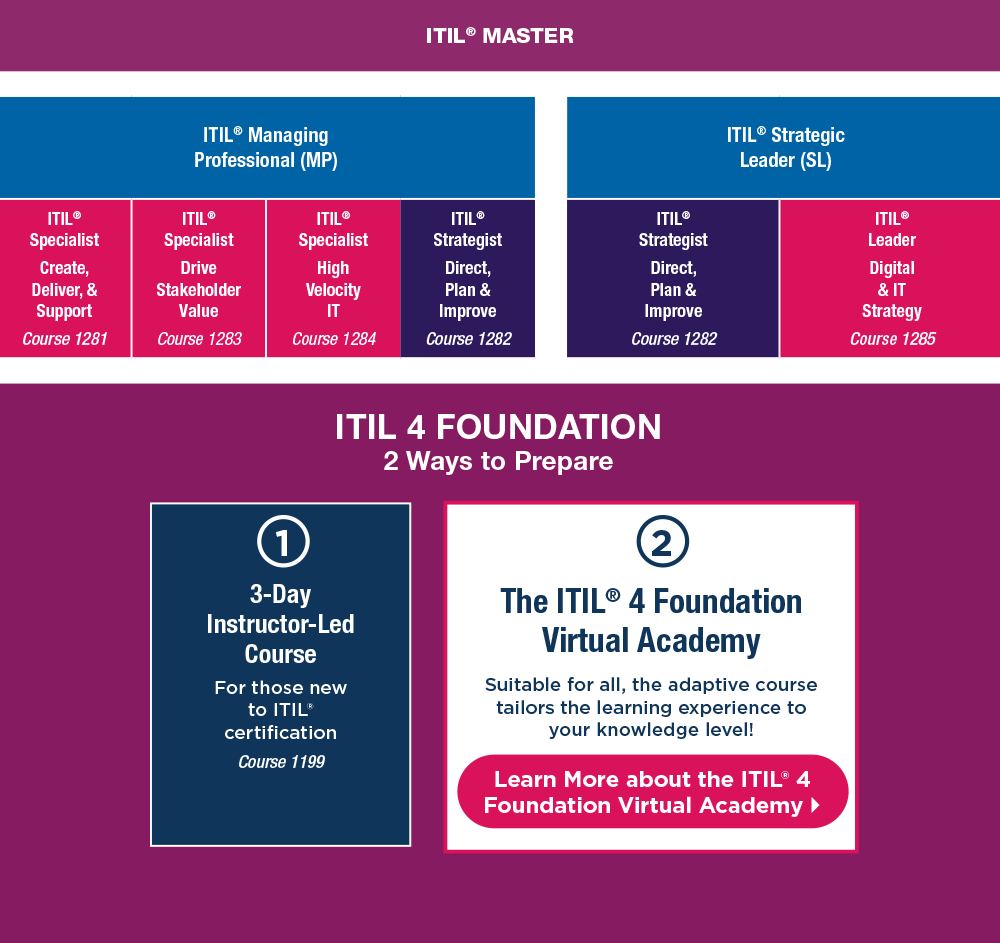With ITIL 4 Foundation live what are our options for transitioning from ITILv3 to ITIL 4 qualification? Let's look at our options.
What is the new ITIL 4 Certification Scheme?
ITIL 4 has been designed to help organizations meet the increasing demand from the current complex digital environment. The ITIL 4 Certification Scheme comprises of the following modules:

I am an ITIL Foundation (v3) certification holder. How should I continue my ITIL journey with ITIL 4?
You should continue accumulating ITIL v3 credits under the current ITIL certification scheme now. Once you've accumulated 17 credits, you can then formally transition your knowledge to ITIL 4 with the ITIL Managing Professional Transition Module.
I'm an ITIL v3 Expert or I've earned 17 ITIL credits but I haven't taken Managing Across the Lifecycle. Do I have to start all over again?
No! To recognize the achievements of individuals who have progressed through the ITIL v3 certification scheme there is an ITIL Managing Professional Transition Module. The ITIL Managing Professional Transition Module is designed for ITIL v3 candidates who are ITIL Experts or who have achieved 17 credits from across the v3 scheme.
Upon successfully passing the exam you will gain the designation of ITIL 4 Managing Professional via one course and one exam. In addition to fully preparing you for this exam, this 5-day ITIL 4 transition module will teach you how to create, deliver, and support services and Drive Stakeholder Value.
After achieving the ITIL Managing Professional (ITIL MP) designation, if you are interested in pursuing the ITIL Strategic Leader stream, you would only need to complete the ITIL Leader Digital & Strategy module to become eligible for ITIL Master.
Does ITIL 4 Foundation count towards the required 17 credits?
ITIL 4 Foundation Certification can be counted as 2 credits but you can't use 2 credits from ITIL 4 Foundation and two credits from ITIL v3 Foundation towards your 17 credits total. Only 2 credits from either qualification.
How do I figure out my ITIL 4 Learning Path?
The table below is a guide to the most suitable ITIL 4 MP module according to their past v3 needs.
| ITIL v3 Module | Primary ITIL 4 MP module | Secondary ITIL 4 MP module(s) |
| Service Strategy (SS) | Direct, Plan and Improve (DPI) | High-Velocity IT (HVIT) |
| Service Design (SD)* | Create, Deliver and Support (CDS)* Drive Stakeholder Value (DSV)* |
High Velocity IT (HVIT) |
| Service Transition (ST) | Create, Deliver and Support (CDS) | High Velocity IT (HVIT) |
| Service Operations (SO) | Create, Deliver and Support (CDS) | * Drive Stakeholder Value (DSV) High Velocity IT (HVIT) |
| Continual Service Improvement (CSI) | Direct, Plan and Improve (DPI) | - |
| Operational Support and Analysis (OSA) | Create, Deliver and Support (CDS) | * Drive Stakeholder Value (DSV) High Velocity IT (HVIT) |
| Planning, Protection and Optimization (PPO) | Drive Stakeholder Value (DSV) | * Create, Deliver and Support (CDS) High Velocity IT (HVIT) |
| Release, Control and Validation (RCV) | Create, Deliver and Support (CDS) | High Velocity IT (HVIT) |
| Service Offerings and Agreements (SOA) | Drive Stakeholder Value (DSV) | * Create, Deliver and Support (CDS) * High Velocity IT (HVIT) |
* Service Design is an exception as has two primary MP modules depending on what the customer is looking for:
Create, Deliver and Support suits best those looking for aspects related to the integration of service design to the overall service management process and how they are created, delivered and supported through different value streams and with a stronger focus on the operations.
Drive Stakeholder Value suits best those looking for an approach to design services from a strategic perspective, focusing on the importance of understanding and interacting with the customer and other stakeholders throughout this process by exploring techniques such as journey mapping for the different stakeholders, CX and UX elements and value co-creation.

